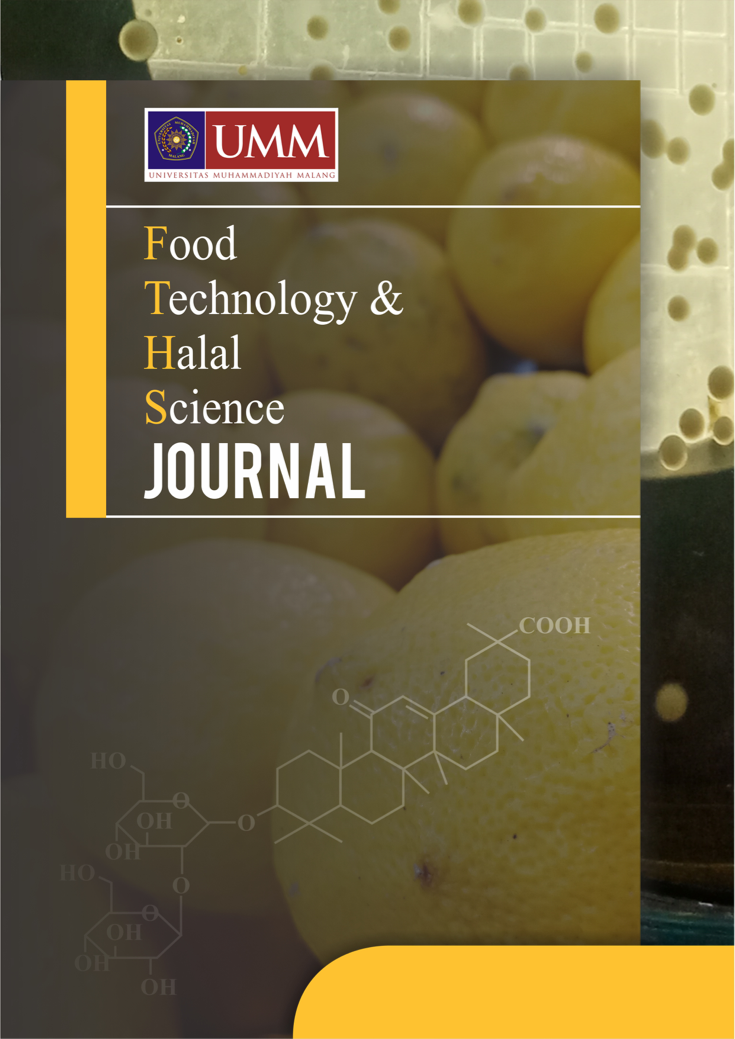Kajian Penambahan Filtrat Kunyit dan Tartrazin Pada Edible Film Berbasis Pati Talas Serta Aplikasinya Untuk Mempertahankan Mutu Dodol Substitusi Rumput Laut (Eucheuma cottonii)
DOI:
https://doi.org/10.22219/fths.v3i1.13059Keywords:
dodol, edible film, food colorant, turmeric, TartrazinAbstract
This research studied the effect of natural colorant (turmeric filtrate) additions compared to synthetic colorant (Tartrazine) additions in taro starch-based edible film on the quality of dodol that substituted with seaweed. This research used a Randomized Block Design with Orthogonal Contrast. The treatment factor consist of turmeric filtrate additions in 1%, 2%, 3%, Tartrazin additions in 0,003%, 0,005%, 0,007% and without colorant as control treatment. Parameters that analyzed consist of thickness, color, transparency, tensile strength, elongation, water vapor transmission rate of edible film, moisture content, fat content, total plate count, texture and organoleptic value of dodol at the 0, 3rd, 6th day of storage. The research result shows that the additions of turmeric filtrate had an effect on increasing thickness, tensile strength, transparency, brightness (L), yellowness (b+), and decreasing the elongation and WVTR of edible film. Meanwhile, the additions of Tartrazin had an effect on increasing transparency, brightness (L), and yellowness (b+). The results of moisture content, fat content, TPC, and texture of dodol showed that the addition of turmeric filtrate is better to maintain the quality of dodol during storage. Additions of 3% turmeric filtrate as the best treatment, has 30.24% and 31.40% in moisture content, 1.16% and 0.97% in fat content, 4.0x103 CFU/g and 0.9x104 CFU/g in TPC, 15.30 N/mm and 14.03 N/mm in texture, 3.53 and 3.63 in color organoleptic value, 3.65 and 3.60 in aroma value and 3.75 and 3.73 in taste value during the 3rd and 6th day of storage.
Downloads
References
Ayu, S. P., A. D. Sutrisno, Doddy dan D. A. Darmajana. 2016. Pendugaan Umur
Simpan Dodol Nanas (Ananas comosus L.) dengan Pengemas Edible Film
Tapioka. Institut Pertanian Bogor. Bogor.
Egan, M. E. M. Pearson., S. A. Weiner, Rajendran V., Rubin D., Glöckner-Pagel
J., Canny S, Du K, Lukacs G. L. dan Caplan M. J., 2004. Curcumin, a Major
Constituent of Turmeric, Corrects Cystic Fibrosis Defects. Science: 600-2.
Estiasih, T. dan Ahmadi. 2009. Teknologi Pengolahan Pangan. Bumi Aksara.
Jakarta.
Friedman, M. 2009. Cinnamaldehyde Content in Foods Determined by Gas
Chromatography-mass Spectrometry. J Agric Food Chem 48 (11):5702-9.
Japanese Industrial Standards. 1997. JIS Z 1707: 1997 General Rules of Plastic
Films for Food Packaging. JSA. Tokyo.
Jay, J. M. 2005. Modern Food Microbiology Seventh Edition. Springer Science
and Business Media. Maryland.
Kampeerapappun dan Piyaporn. 2007. Preparation of Cassava Starch/
Montmorillonite Composite Film. Chulalongkorn University. Bangkok.
Kusumawati, D. H dan W. D. R. Putri. 2013. Karakteristik Fisik dan Kimia
Edible Film Pati Jagung yang diinkorporasi dengan Perasan Temu Hitam.
Jurnal Pangan dan Agroindustri Vol. 1, No. 1. Halaman: 90–100.
Nasaputra, M. A. 2012. Pengaruh Konsentrasi Pati Jahe Emprit (Zingiber
officinale var. Rubrum) dan Asam Stearat terhadap Karakteristik Fisik,
Kimia, dan Organoleptik Edible Film. Skripsi. Universitas Brawijaya.
Malang.
Pangesti, A. D., A. Rahim dan G. S. Hutomo. 2014. Karakteristik Fisik, Mekanik
dan Sensoris Edible Film dari Pati Talas pada berbagai Konsentrasi Asam
Palmitat. E-J. Agrotekbis. 2 (6): 604-610.
Sachiko, A. 2002. The Determinant of Food Preference. Journal for the
Integrated Study of Dietary Habits. Vol. 13. Halaman 17-21.
Santoso, B., A. Marsega., G. Priyanto dan R. Pambayun. 2016. Perbaikan Sifat
Fisik, Kimia dan Antibakteri Edible Film Berbasis Pati Ganyong. Jurnal
Agritech, Vol. 36, No. 4. Halaman 379-386.
Standar Nasional Indonesia. 2013. Dodol Beras Ketan. SNI-2986:2013. Badan
Standarisasi Nasional. Jakarta.
Syarifuddin, A. dan Yunianta. 2015. Karakterisasi Edible Film dari Pektin Jeruk
Bali. Jurnal Pangan dan Agroindustri. Vol 3, No. 4. Halaman 1538-1547.
Tarwiyah. 2001. Minyak Atsiri Jahe. Online. Diakses pada 5 November 2018.
Winarno, F. G. 2004. Keamanan Pangan. Jilid 1. Gramedia Pustaka Utama.
Jakarta.
Wulandari, Y. 2017. Karakterisasi Edible Film dari Pati Umbi Talas (Colocasia
esculenta (L.) Schott) dengan Penambahan Kitosan pada Dodol Substitusi
Rumput Laut (Eucheuma cottonii L.). Skripsi. Universitas Muhammadiyah
Malang. Malang.
Yuliati. 2016. Uji Efektivitas Ekstrak Kunyit sebagai Antibakteri dalam
Pertumbuhan Bacillus sp dan Shigella dysentriae secara In Vitro. Jurnal
Profesi Medika Vol. 10, No. 1. Halaman 26-32.
Downloads
Published
How to Cite
Issue
Section
License
Authors who publish with this journal agree to the following terms:
- Authors retain copyright and grant the journal right of first publication with the work simultaneously licensed under a Creative Commons Attribution License that allows others to share the work with an acknowledgement of the work's authorship and initial publication in this journal.
- Authors are able to enter into separate, additional contractual arrangements for the non-exclusive distribution of the journal's published version of the work (e.g., post it to an institutional repository or publish it in a book), with an acknowledgement of its initial publication in this journal.
- Authors are permitted and encouraged to post their work online (e.g., in institutional repositories or on their website) prior to and during the submission process, as it can lead to productive exchanges, as well as earlier and greater citation of published work (See The Effect of Open Access).










